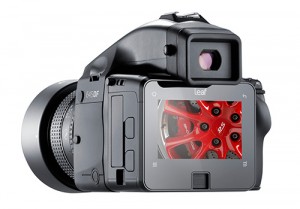Leaf Credo

Leaf Credo are Leaf latest generation of digital camera backs and are also first new backs after Phase One purchased Leaf and which are not based on previous models. Still advertised as Mamiya Leaf Credo instead to be under Phase One name. Biggest changes are that the backs doesn’t use active cooling /fan/ but used passive cooling /Peltier element/. Leaf Credo digital backs also have better high-resolution iPhone-like touch screen which doesn’t support stylus usage. Backs start using Phase One OS which allows the much faster boot up which take less than one second, where previously it took up to 10 seconds on Aptus units which were based on Windows CE operating system.
Leaf Credo 40 and Leaf Credo 80 are most popular models on the market.
Slow boot time is one of biggest frustrations for Leaf digital backs owners.
The differences between Credo and Aptus II:
- Interface: Leaf Credo Digital backs support tethered connection both via USB 3.0 and Firmware 800 interfaces. 10-meter firmware cables can be used and 3 meters USB 3.0 Cables. For USB cables with repeaters, it can be used 7.5 and 10-meter cables. Leaf Aptus-II digital backs don’t have USB ports and need special L-shaped firmware cables.
- The battery of Leaf Credo Backs is an internal one, and they can be powered on only with fully charged battery. When used in tethered mode battery is charged with use of powered FW cables, but not when the USB cable is used. Leaf Aptus II digital backs use like previous models external battery which slide into a slot in the lower part of the back which allow the use of a double capacity battery, but remove the possibility of battery use during tethering. Therefore, Leaf Aptus II digital backs can be tethered only via powered FW cables.
- Leaf Credo digital backs have the newer generation, smaller but higher resolution LCD screens which have capacity touchscreens. Leaf Aptus II digital backs are using the older bigger generation of screens with resistive touch screen /like older PDAs/.
- Connection protocols: Leaf Credo digital backs benefits for much faster and stable connection when tethering compared to previous generation Aptus Backs.
- Colors: Leaf Credo colors are more accurate and less punchy and unique than Aptus colors.
- Sensitivity – Credo is 1/3 stop more sensitive to light than Aptus, using the same ISO settings.
- Body compatibility: Leaf Aptus can work on all 645 Mamiya models from AFD and upwards. Credo requires Phase 645 DF body and upwards, and can work with 645AFD III only when version 1 of the firmware is installed on it. Interfacing to non-Mamiya 645 bodies, such an RZ67, HY6, Hasselblad H and Hasselblad V series, Contax, tech cameras is unchanged from Aptus.
- Long exposures: Credo can do much longer exposures than Aptus backs with less visible noise.
- Noise: Credo has slightly less noise in high ISO than Aptus in normal length exposures.
- File format: Leaf Credo produces IIQ files same as Phase One backs. There are two types of files: large and small. Large has no compression and small has some compression and about half the size. The “Large” files can be opened by Adobe Photoshop and Lightroom. IIQ files are not compatible with Leaf Capture.
- Live view: Credo has live view on the back’s screen – Aptus has live view only on a tethered computer. Since both live views are CCD based, they are significantly inferior to live views on current CMOS sensors.
- All ports in the Credo body are covered (“weather sealed”).
- Credo body is made of metal, Aptus has plastic/metal combination. Leaf Credo has passive cooling based on Peltier element while Aptus backs have active cooling with fan, which makes some noise and can make the back freeze in icy winds.
- Leaf Aptus has a detachable LCD protector cover which Leaf Credo does not have.
- Turning on/off: Tethered Aptus automatically turns on when the computer is turned on, and autocratically turns off when the computer is turned off. Leaf Credo must be turned on and off manually, and also turns off automatically after a period of idle time.
Leaf Current Models:
| Model | Sensor Size | Resolution | Active Pixels | ISO range | Dynamic range | Frames per Second | Lens conversion factor | Display | Storage | Host Connection | Released |
|---|---|---|---|---|---|---|---|---|---|---|---|
| Credo 50 | 44 x 33 mm | 50 MP, 16 bit | 8280 x 6208 | 100-6400 | 14 f-stops | 1.2 | 1.25 | 3.2-inch 1.5-megapixel Retina-type multi touchscreen | CF up to UDMA 6 | IEE1394b Firewire800 and USB3 | 2014 |
| Credo 80 | 53.7 x 40.4 mm | 80 MP, 16 bit | 10328 x 7760 | 35800 | 12.5 f-stops | 0.7 | 1 | 3.2-inch 1.5-megapixel Retina-type multi touchscreen | CF up to UDMA 6 | IEE1394b Firewire800 and USB3 | 2012 |
| Credo 60 | 53.9 x 40.4 mm | 60.5 MP, 16 bit | 8984 x 6732 | 50800 | 12.5 f-stops | 1 | 1 | 3.2-inch 1.5-megapixel Retina-type multi touchscreen | CF up to UDMA 6 | IEE1394b Firewire800 and USB3 | 2012 |
| Credo 40 | 43.9 x 32.9 mm, | 40 MP, 16 bit | 7320 x 5484 | 50800 | 12.5 f-stops | 1.2 | 1.25 | 3.2-inch 1.5-megapixel Retina-type multi touchscreen | CF up to UDMA 6 | IEE1394b Firewire800 and USB3 | 2012 |
Copyright: Teo Totev


























































